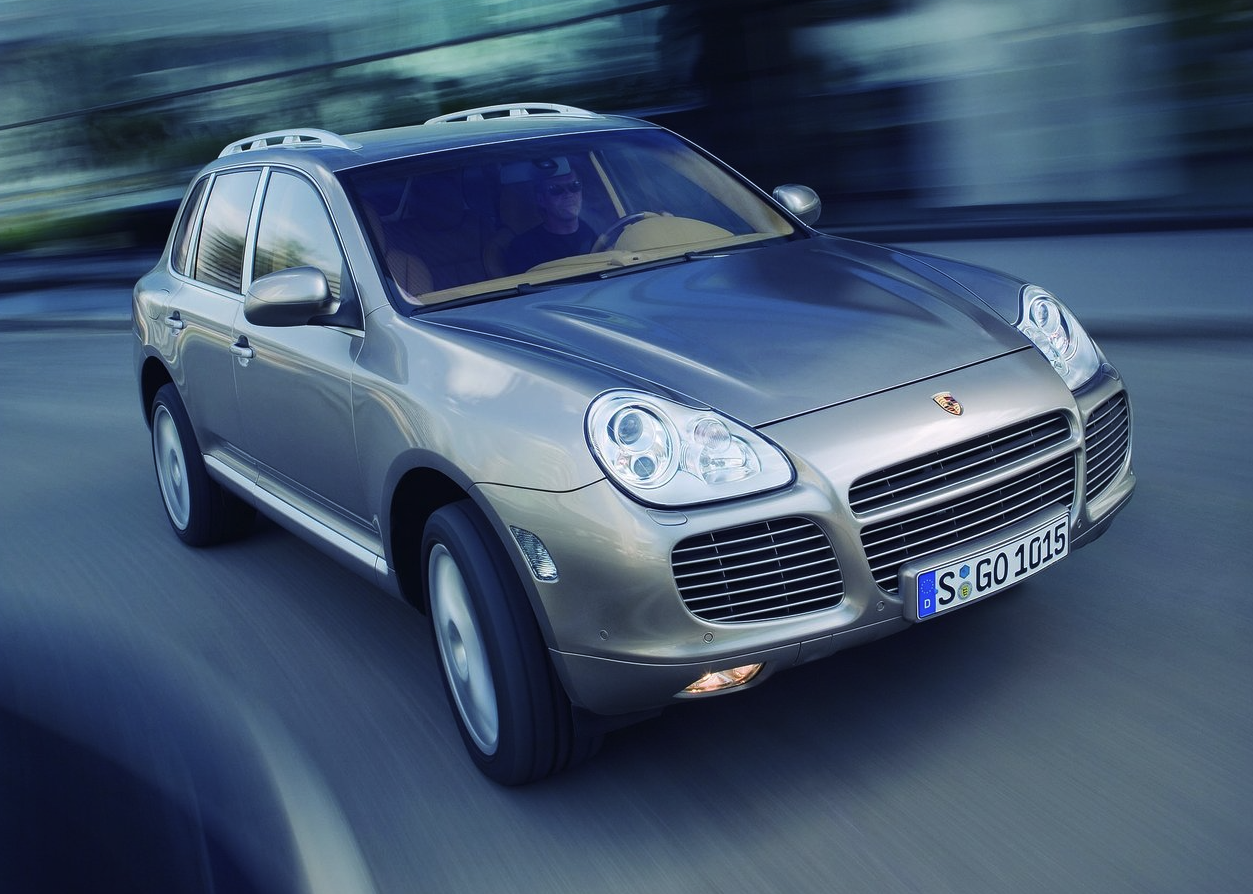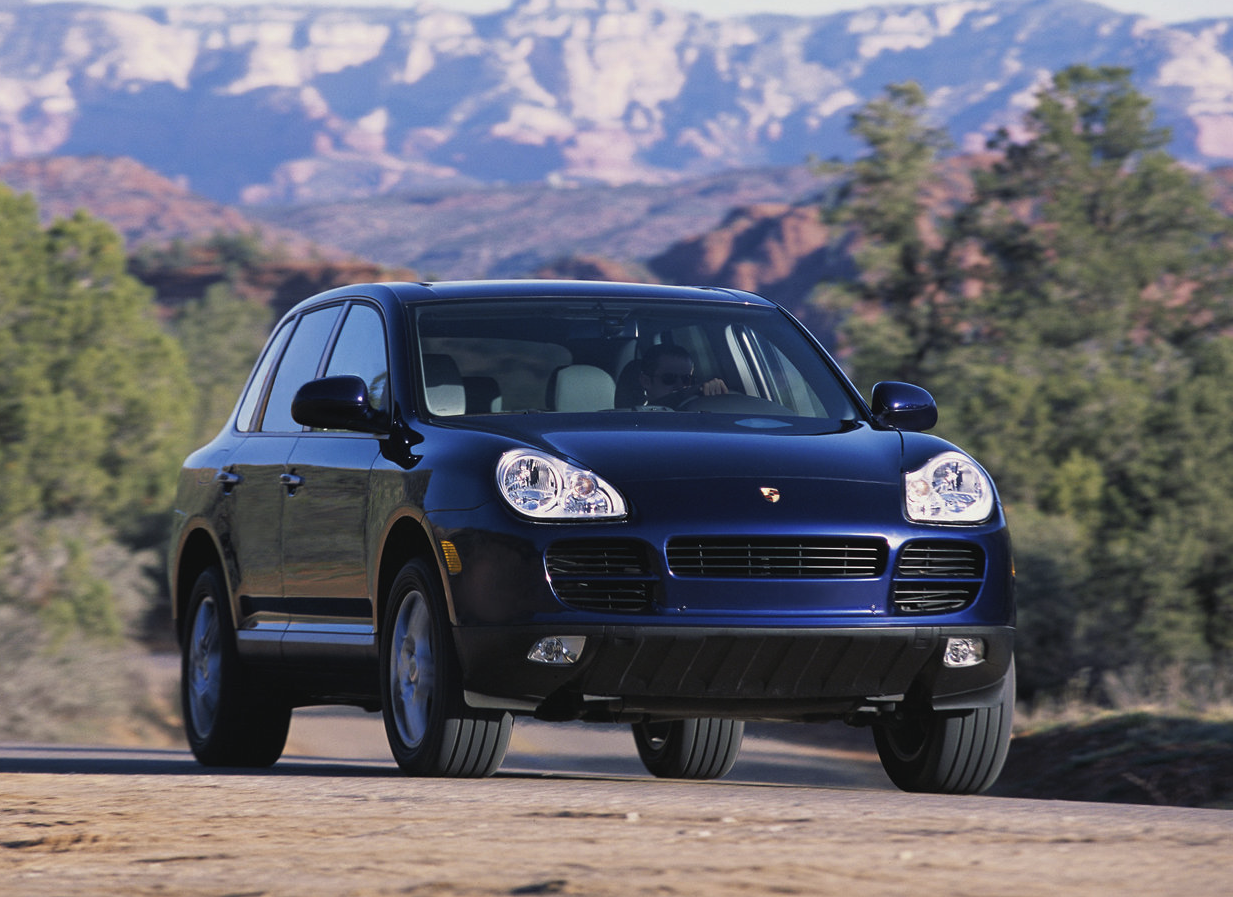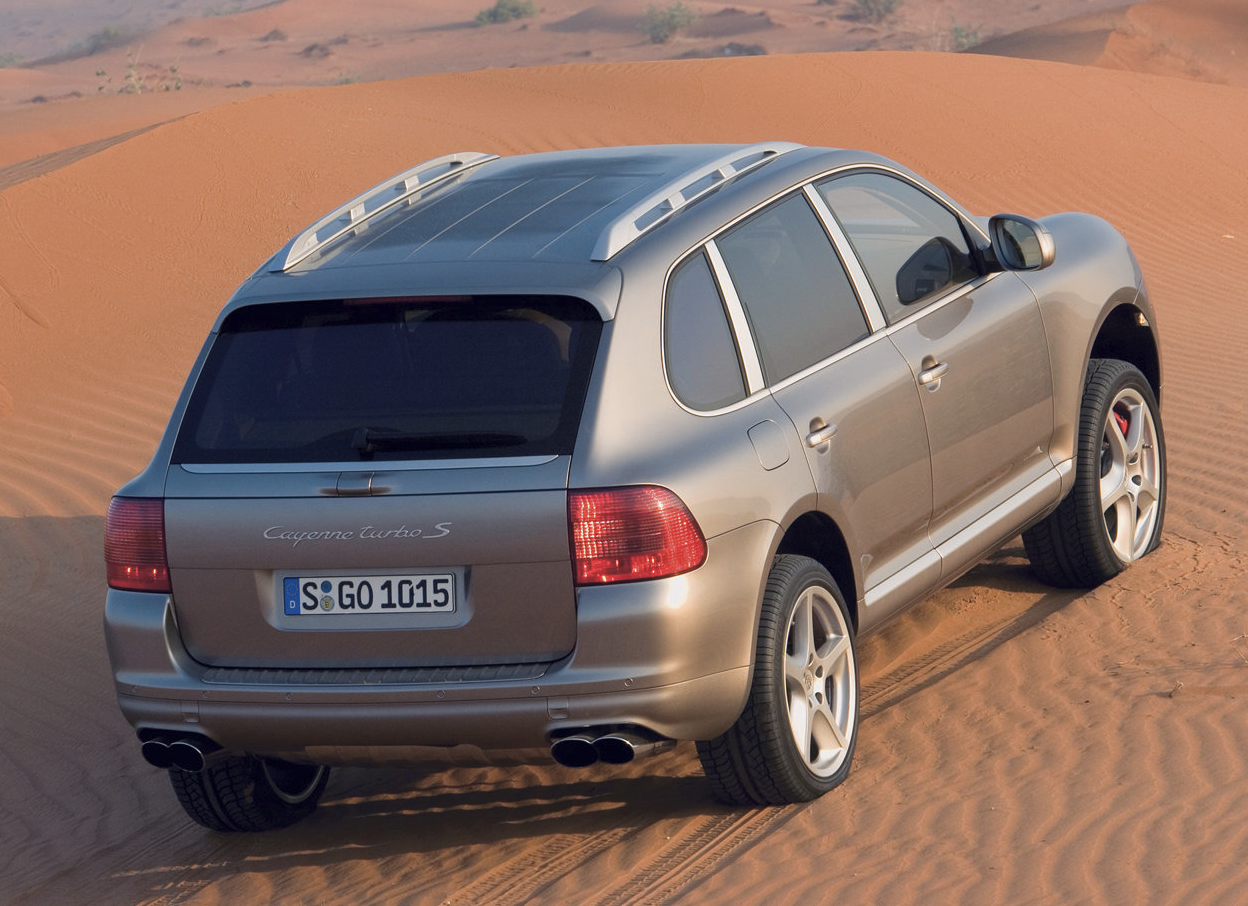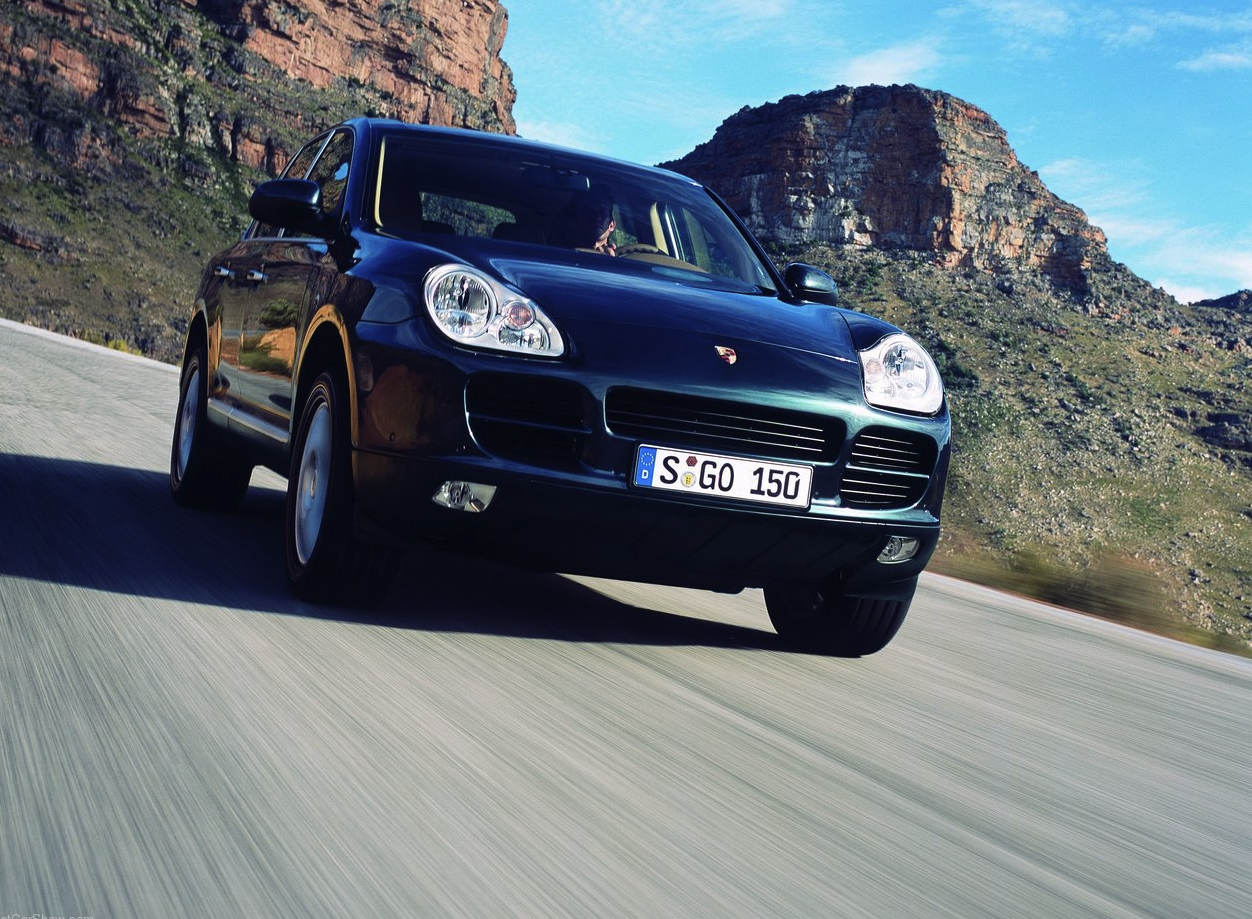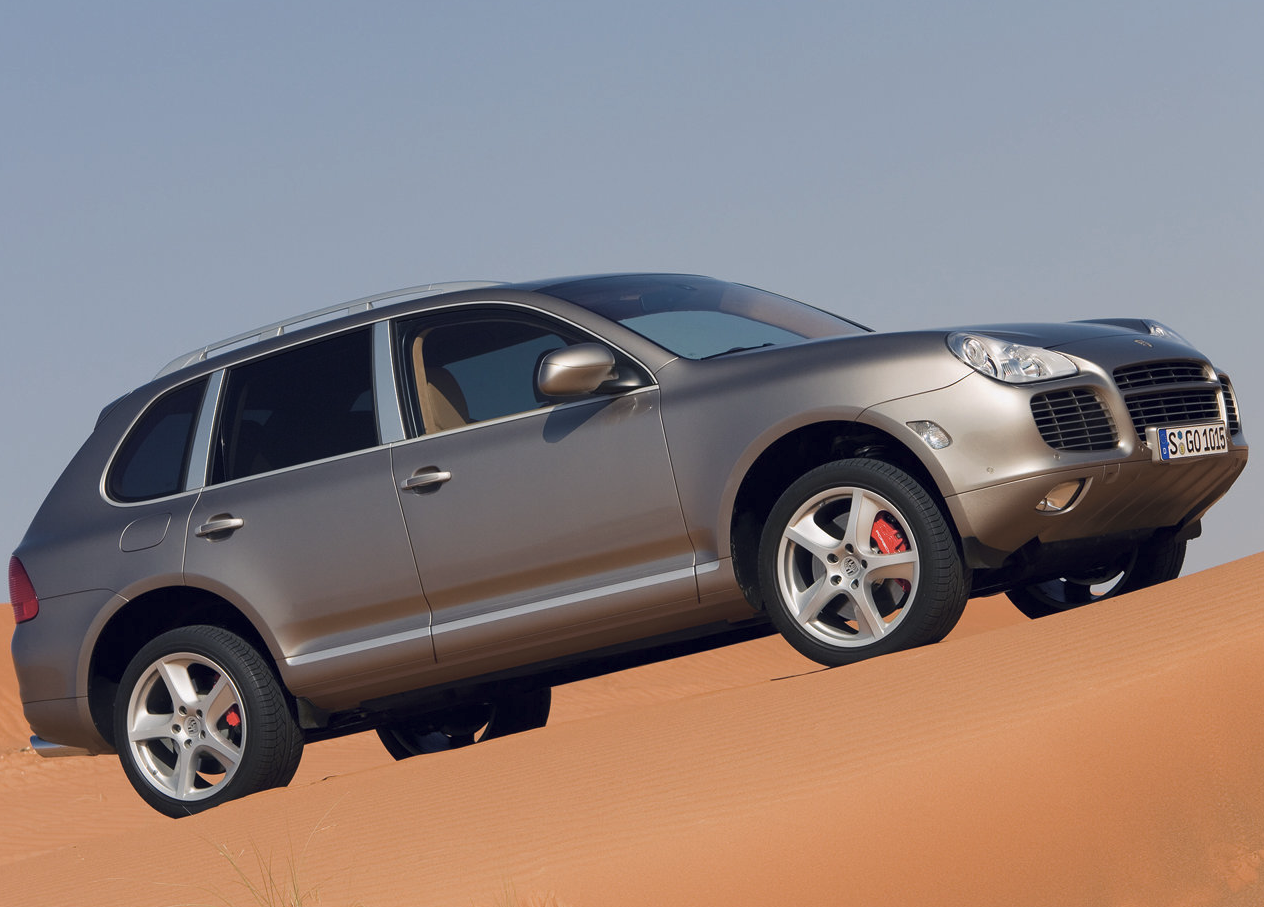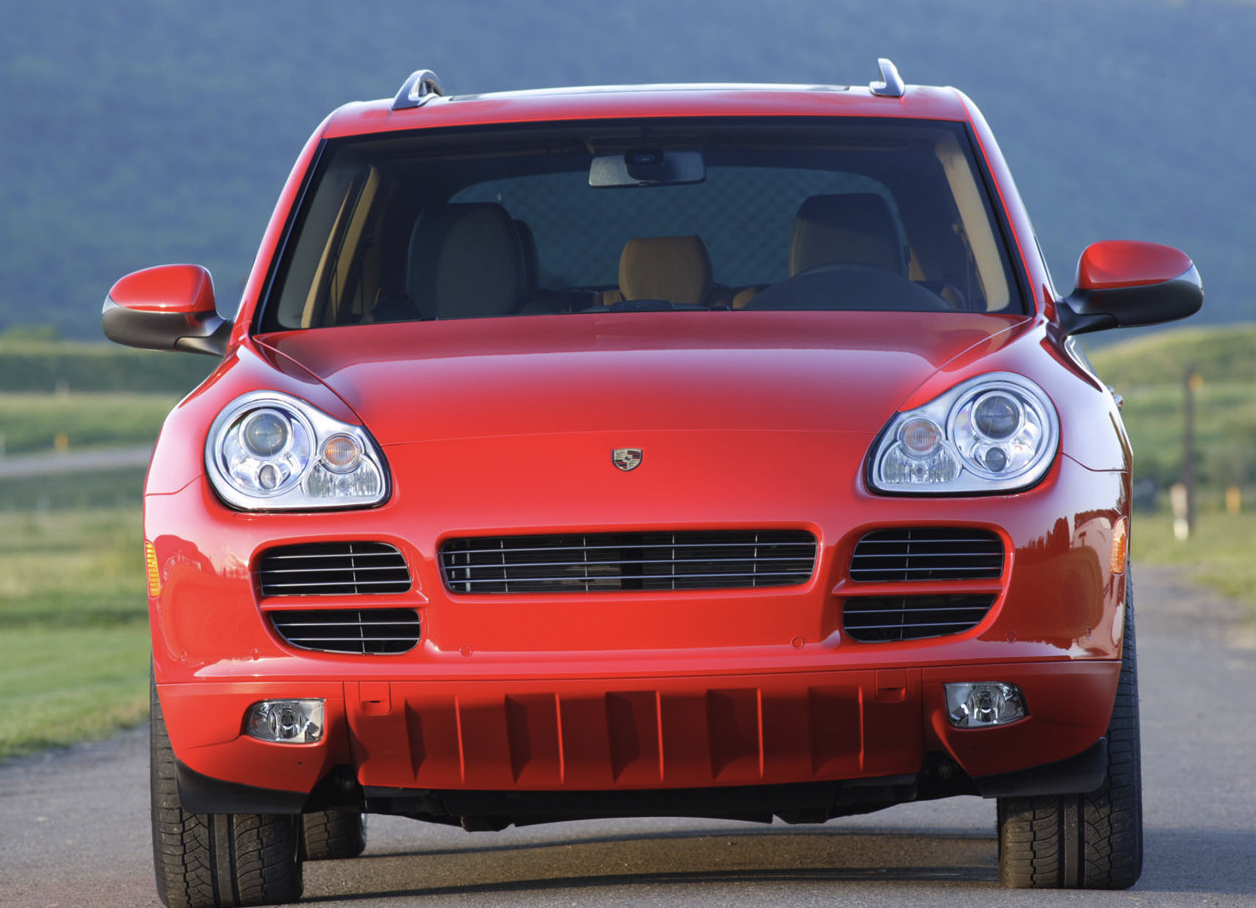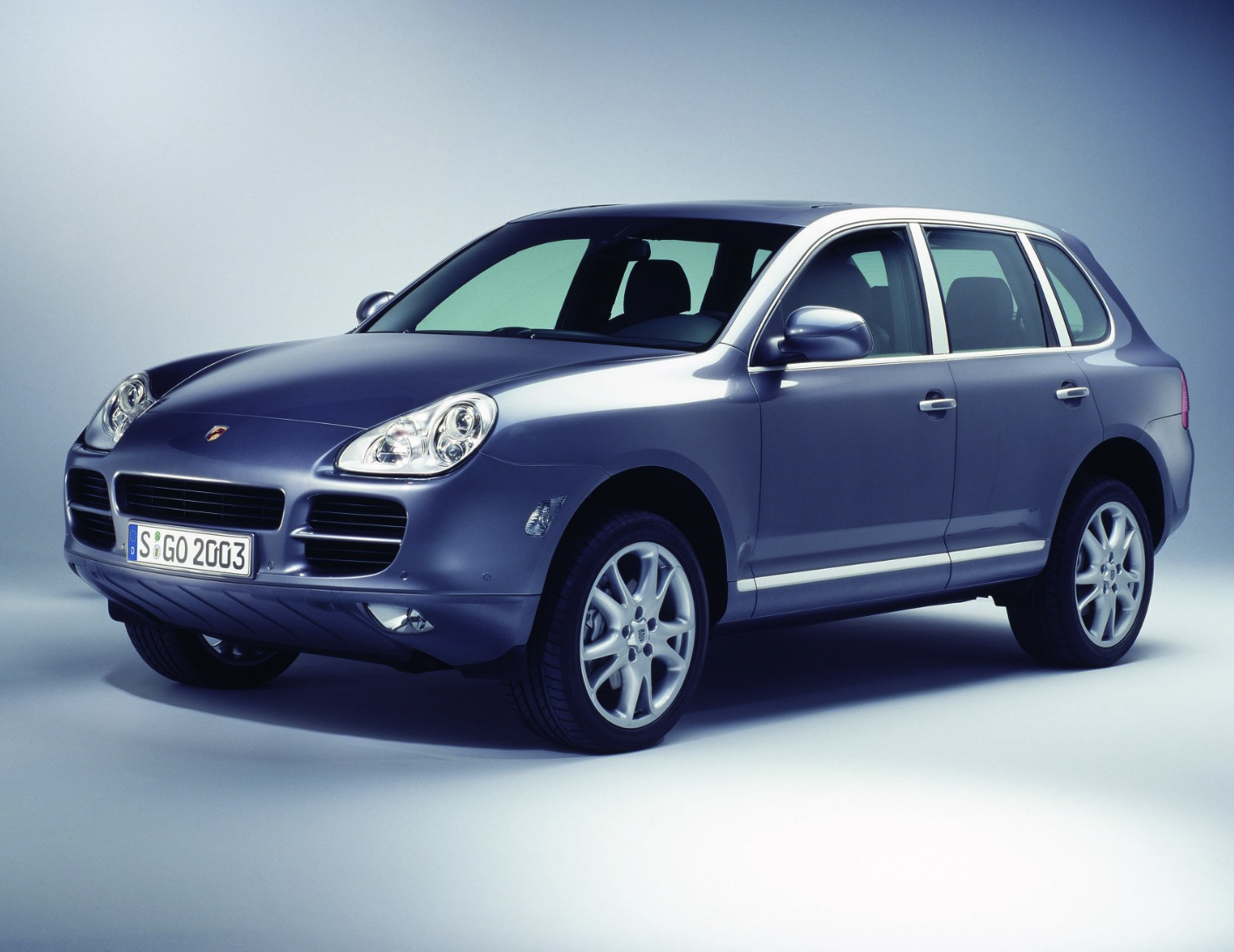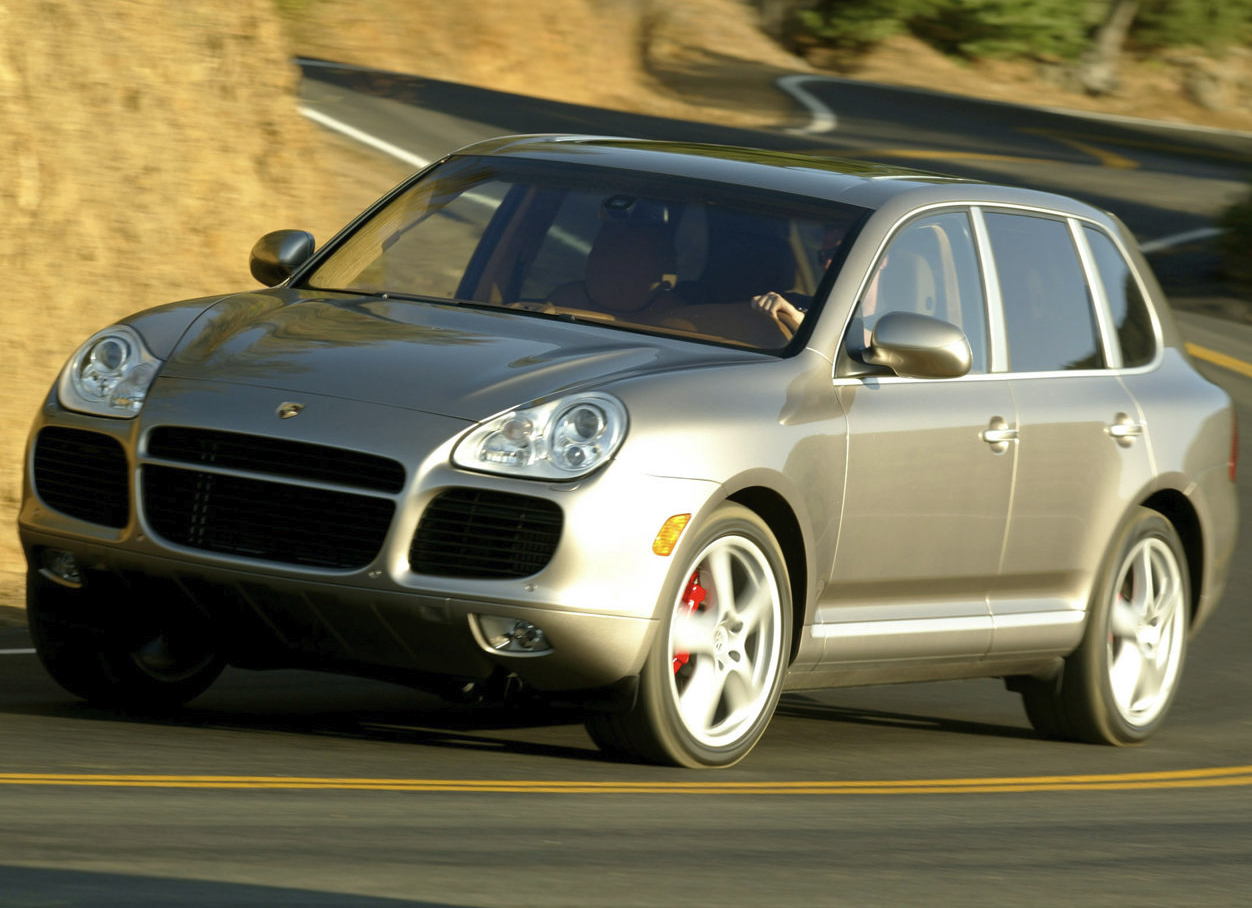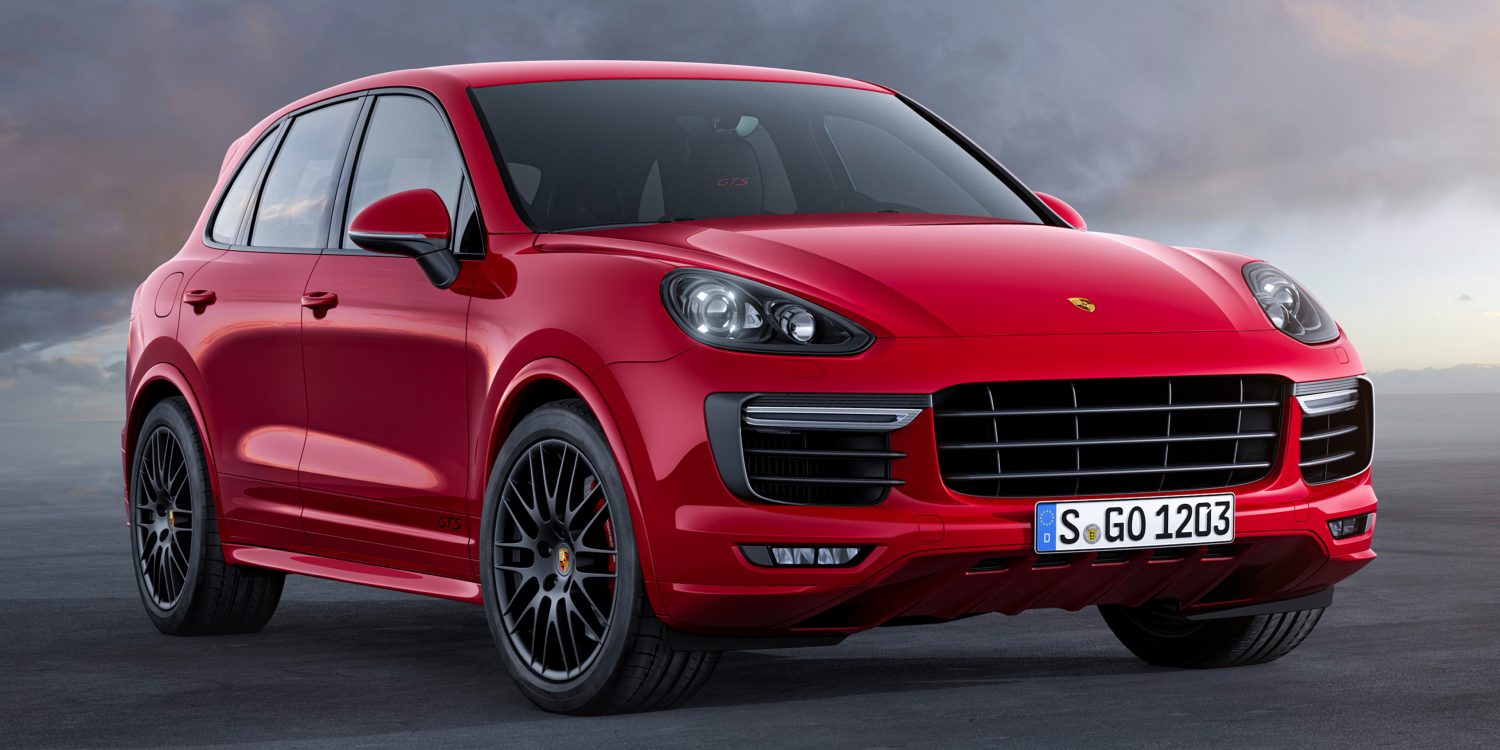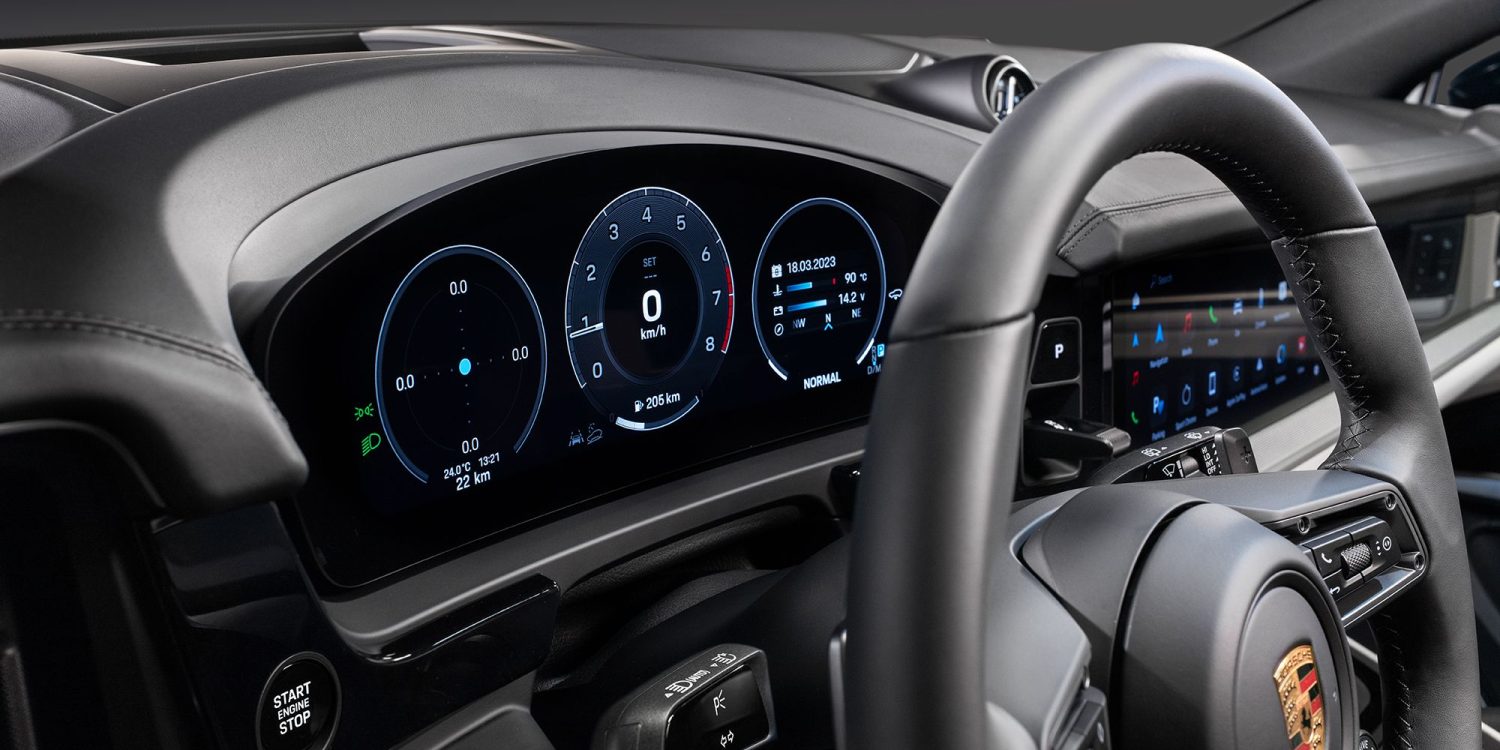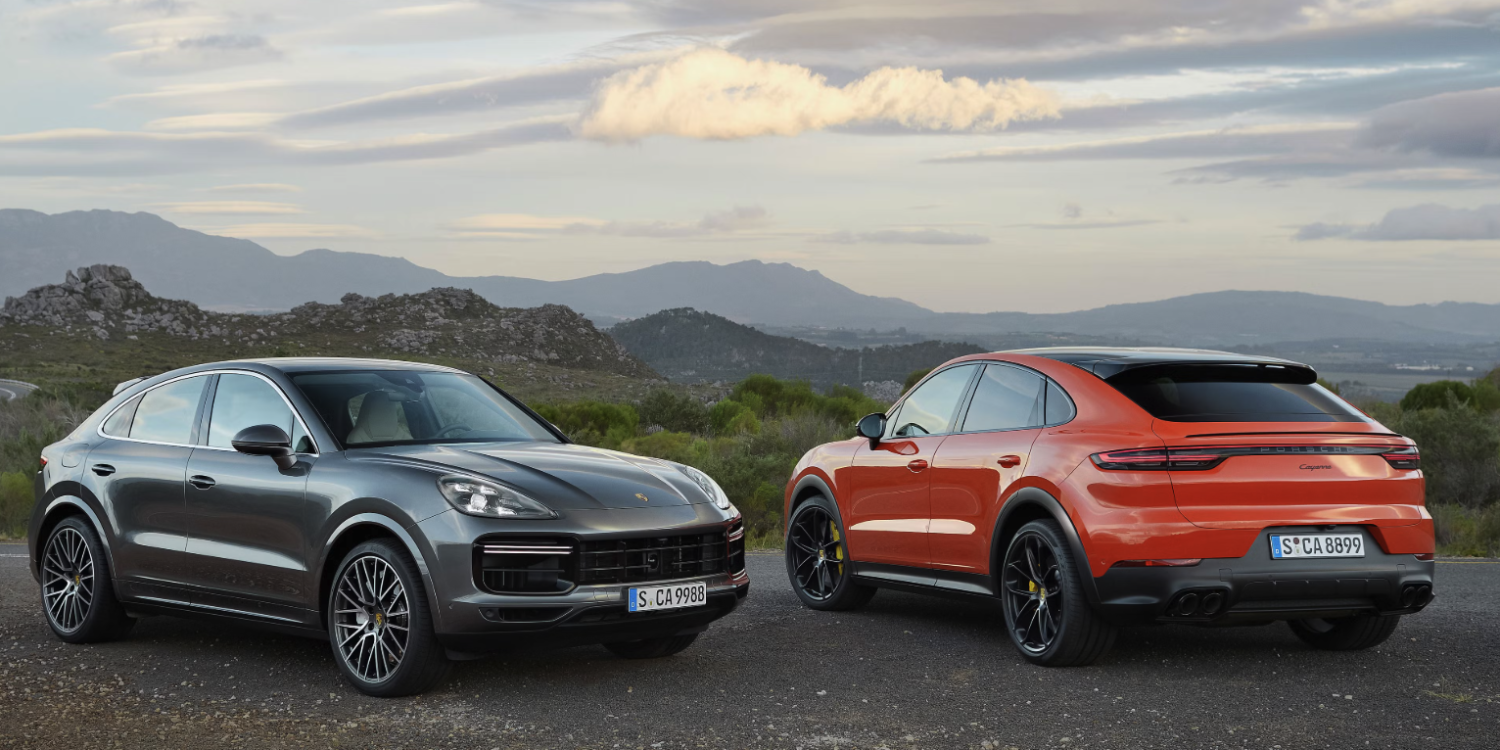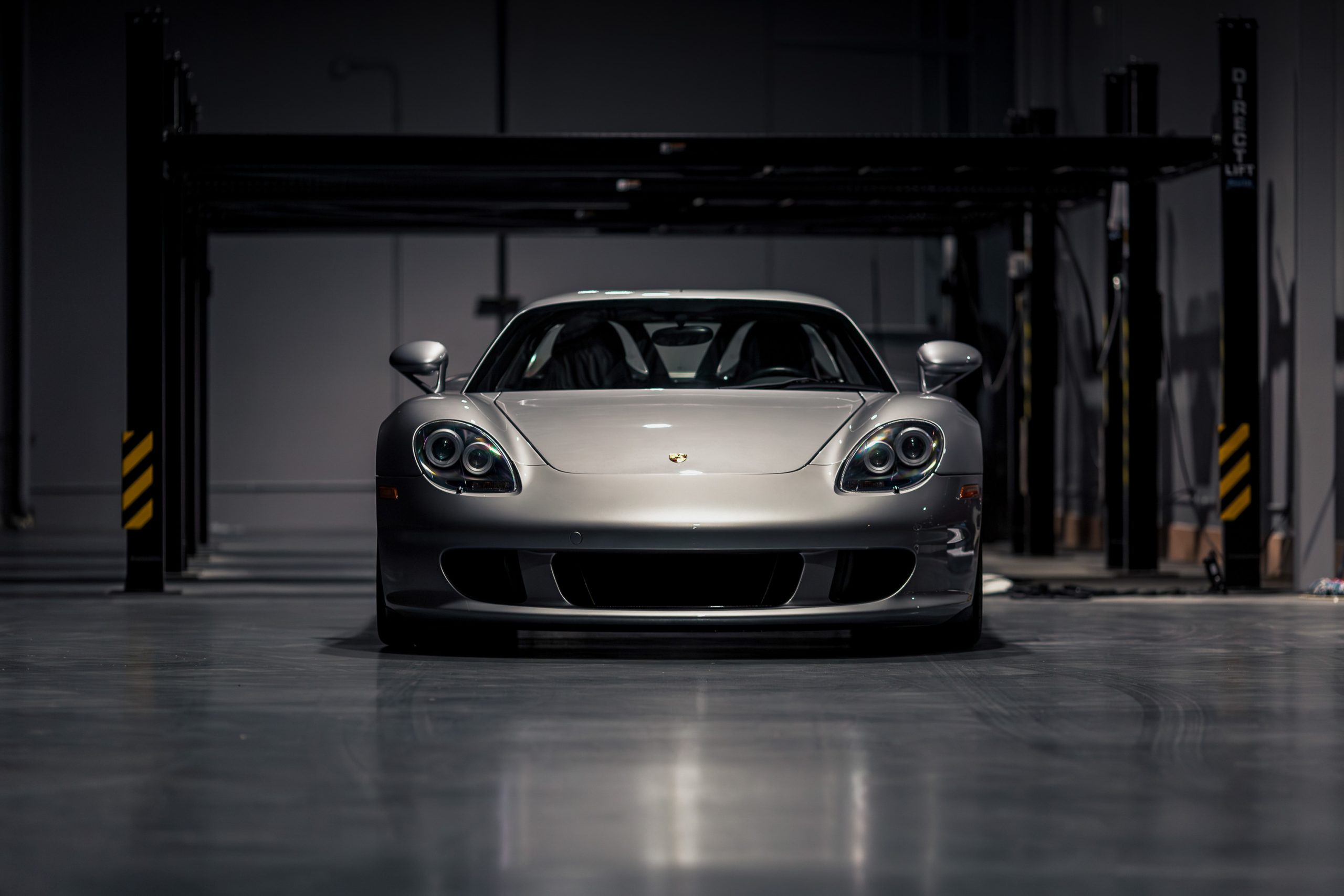1st Generation Porsche Cayenne Buyer's Guide
Buying a first generation Cayenne? Our Guide Covers Key Models, Potential Issues, Values, Tips & More.
The first-generation Porsche Cayenne, internally known as the 955 and 957, marked a major turning point in Porsche’s history. Introduced in 2003, it was the brand’s first SUV—a bold move that raised eyebrows at the time but ultimately proved to be a masterstroke. With its combination of luxury, off-road capability, and genuine Porsche performance, the Cayenne set the benchmark for performance SUVs and helped financially stabilize the company. It’s since gained a reputation as a versatile, high-value modern classic with strong enthusiast appeal.
What makes the first-gen Cayenne especially compelling today is the wide variety of models and configurations available. From the V6-powered base models to the muscular Cayenne S, the athletic GTS, and the ferocious Turbo and Turbo S variants, there’s a Cayenne to match every driving style and budget. The later 957 (2008–2010) refresh brought updated styling, more powerful engines, and improved reliability, making those years particularly attractive for buyers looking for the best balance of performance and refinement. The Cayenne GTS is often considered the enthusiast’s choice, with its naturally aspirated V8, sport-tuned suspension, and distinctive looks.
In this comprehensive First-Generation Porsche Cayenne Buyer’s Guide, we’ll cover everything you need to know before buying—from key model differences and known issues to ownership costs, market values, expert buying tips, and what to expect from day-to-day driving. Whether you're looking for a capable luxury SUV, a performance bargain, or a future collectible with Porsche pedigree, the first-gen Cayenne offers an impressive package that’s aged better than many expected.
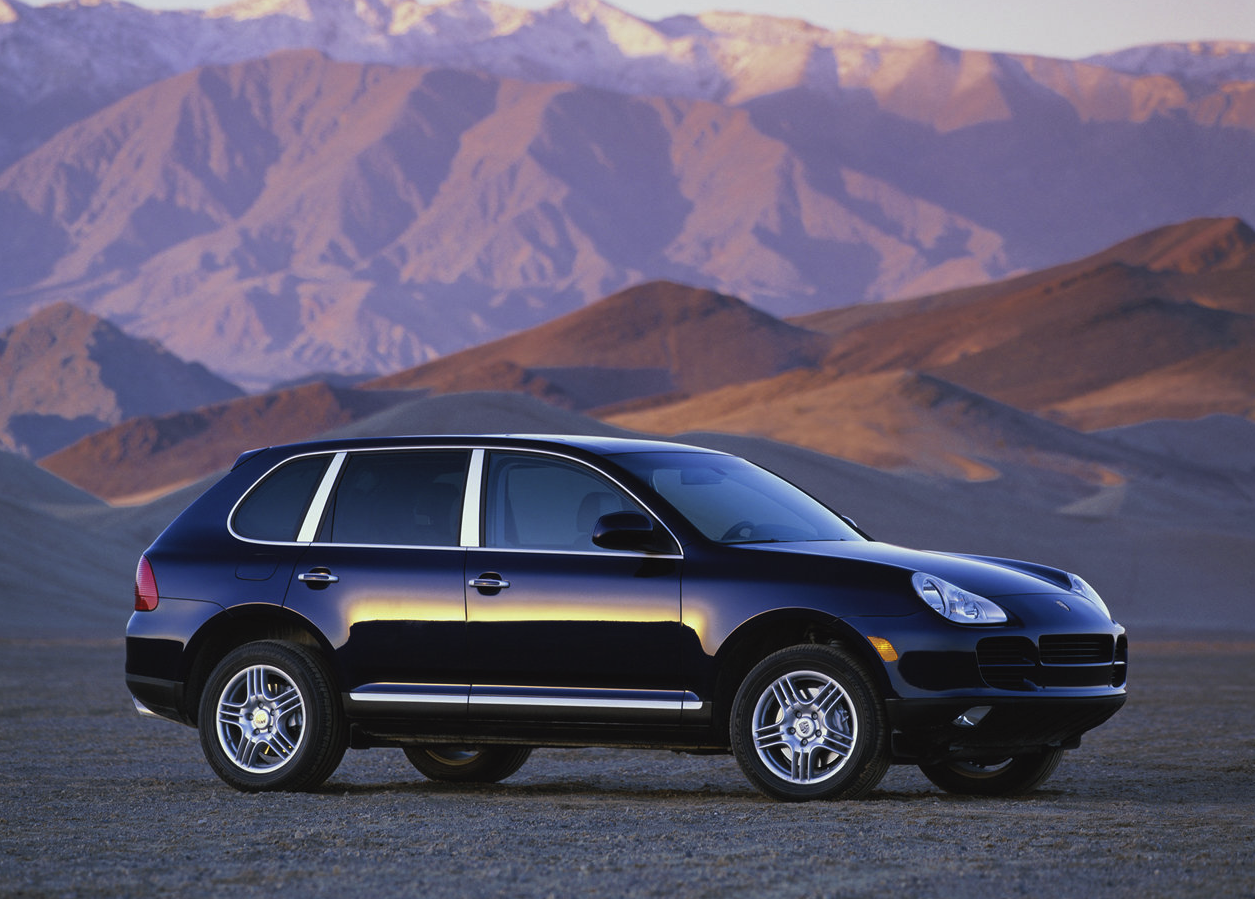
Why the 1st Gen Porsche Cayenne is a Unique Classic to Buy
The first-generation Porsche Cayenne (2003–2010) is a unique and increasingly respected modern classic because it defied expectations—and succeeded. When Porsche introduced its first SUV, purists were skeptical, but the Cayenne proved that a luxury utility vehicle could still deliver genuine Porsche performance. Built on a platform co-developed with Volkswagen (shared with the Touareg), the Cayenne offered an unprecedented mix of off-road capability, high-speed stability, and luxury comfort, all while maintaining the brand’s DNA. Today, it stands as a bold example of Porsche’s evolution and a tangible symbol of the brand's ability to adapt without compromising its core values.
What truly sets the first-gen Cayenne apart is the breadth of its powertrain options and driving personalities. Whether it’s the reliable 3.2L or 3.6L V6 in the base model, the torque-rich 4.5L and 4.8L V8s in the Cayenne S and GTS, or the fire-breathing twin-turbocharged V8s in the Turbo and Turbo S, there’s a configuration to suit nearly every driving preference. The Cayenne GTS, in particular, has gained a strong enthusiast following for its naturally aspirated V8, lowered sport suspension, and aggressive styling. It represents the sweet spot between performance and daily usability without the complexity of turbocharging.
Beyond performance, the 955 and 957 Cayenne models were designed to be true multi-purpose vehicles. With adjustable air suspension, a locking center differential, and a low-range transfer case, even early Cayennes were surprisingly capable off-road—something most modern luxury SUVs can’t claim. At the same time, the cabin offered high-quality materials, a driver-focused layout, and optional features like heated rear seats, premium Bose audio, and air-conditioned front seats. This balance of ruggedness and refinement makes the first-gen Cayenne stand out in a market where many SUVs are either too soft or too specialized.
From an investment and ownership perspective, the first-gen Cayenne is also beginning to earn recognition as a future collectible, especially well-preserved examples of the Turbo S, GTS, and rare special trims. Prices remain affordable for now, especially considering the performance and brand pedigree, but as clean examples become harder to find—and as modern enthusiasts seek analog driving experiences with real personality—the Cayenne’s status as a modern classic with unique versatility will only grow. It’s a Porsche you can daily drive, take on a backroad, or even trail, and that kind of flexibility makes it truly one of a kind.
1st Gen Cayenne Variants - A Quick Primer for Potential Buyers On The Variants & Specials To Think About.
We already have ultimate guide to the Porsche Cayenne (955/957) so we don't want to repeat everything here. Instead, we will give you a quick primer and summary about the main first generation Cayenne variants, some of the core model year changes and we will talk about some special editions worth noting as you think about your potential purchase.
Key Variants & Differences
The first-generation Porsche Cayenne, split into the 955 (2003–2006) and 957 (2008–2010) designations, is a surprisingly diverse platform with a wide range of engines, trims, and personalities. From practical base models to V8-powered luxury bruisers and track-tuned SUVs, the 955/957 Cayenne lineup offers a variant for every type of driver. Understanding the key differences between these models is crucial for buyers seeking the right balance of performance, reliability, and value.
Cayenne (Base Model) – V6 Utility with Porsche DNA
The entry-level Cayenne came with a 3.2L V6 (955) producing around 247 hp, upgraded to a 3.6L V6 (957) with 290 hp in 2008. It’s the most affordable and practical option, offering solid performance and towing capacity with fewer maintenance costs than the V8s. Most V6 Cayennes came with a 6-speed automatic, though a 6-speed manual was available in earlier years—a rare and quirky choice for a Porsche SUV. These models are capable daily drivers and benefit from the same capable chassis and AWD system, but lack the punch of their V8 siblings.
Cayenne S – The Sweet Spot of Power and Comfort
The Cayenne S is often considered the “just right” model. The 955 version uses a 4.5L naturally aspirated V8 with 340 hp, while the 957 Cayenne S (2008+) steps up to a 4.8L V8 making 385 hp. Both engines deliver strong torque, better performance, and a more refined driving experience. These models also offer more standard luxury features, larger wheels, and access to options like the air suspension system and Porsche Active Suspension Management (PASM). For many buyers, the Cayenne S provides the best balance of performance, reliability, and value.
Cayenne GTS – The Enthusiast’s Choice
The Cayenne GTS is a standout in the 957 generation (2008–2010). Powered by a 4.8L naturally aspirated V8 tuned to 405 hp, it features lowered suspension, PASM as standard, sportier bodywork, and unique interior accents. It was available with a 6-speed manual transmission in the early years—an extremely rare and highly sought-after spec. The GTS was designed to be the most dynamic-driving Cayenne without turbocharging, and it delivers sharper handling and a more visceral experience while retaining the SUV's daily usability. For many Porsche enthusiasts, this is the first-gen Cayenne to own.
Cayenne Turbo – The High-Speed Hammer
The Turbo took the Cayenne’s performance to another level. The 955 Turbo (2003–2006) used a twin-turbocharged 4.5L V8 making 450 hp, while the 957 Turbo (2008–2010) bumped output to 500 hp with its 4.8L twin-turbo V8. These models come standard with air suspension, PASM, larger brakes, and a long list of luxury features. Performance is explosive for an SUV, and the Turbo’s tuning makes it feel more like a high-riding 911 than a luxury cruiser. These are more complex and expensive to maintain, but they offer staggering capability.
Cayenne Turbo S – The Flagship Beast
The Turbo S was Porsche’s flagship SUV, only available in limited numbers and only during select years (2006 in the 955; 2009–2010 in the 957). The 955 Turbo S produced 520 hp, while the 957 Turbo S hit 550 hp. Beyond raw power, these variants received upgraded brakes, enhanced interior materials, and nearly every available option as standard. They are rare, fast, and highly collectible, but also come with high operating costs. Still, for those who want the ultimate first-gen Cayenne, the Turbo S is the top of the pyramid.
From the practical and affordable V6 models to the rare and raucous Turbo S, the first-gen Porsche Cayenne (955/957) offers a surprisingly broad range of personalities. If you want daily comfort and balanced performance, the Cayenne S is a smart buy. If you're after track-inspired thrills, the GTS is the enthusiast's pick. And if you want brute-force power and exclusivity, a Turbo or Turbo S delivers it in spades. No matter the variant, the 955/957 Cayenne delivers Porsche character in a package that continues to grow in appreciation among savvy buyers.
Model Year Changes (2003-2010)
Understanding the model year changes of the first-generation Porsche Cayenne—known internally as the 955 (2003–2006) and 957 (2008–2010)—is essential for buyers looking to make an informed decision. While the platform remained largely consistent in terms of layout and engineering, Porsche made several key updates over its lifespan that affected performance, reliability, features, and overall appeal. Here's an expert breakdown of what changed across the model years:
2003 (Launch Year – 955)
The Porsche Cayenne made its debut in 2003 in three initial trims: Cayenne (V6), Cayenne S, and Cayenne Turbo. The base model came with a 3.2L VR6 engine sourced from Volkswagen, the Cayenne S featured a naturally aspirated 4.5L V8, and the Turbo got a twin-turbocharged version of the same V8, producing a then-impressive 450 horsepower. Standard features included Porsche’s permanent all-wheel drive, air suspension (optional on V6/S, standard on Turbo), and available low-range gearing, giving the Cayenne genuine off-road capability.
2004–2006 (955 Continues with Refinement)
These years were mostly evolutionary, though Porsche refined electronics, interior materials, and reliability in subtle ways. The Cayenne V6 gained minor software updates for smoother power delivery, and the V8 models saw improvements in throttle response and transmission behavior. In 2006, Porsche introduced the Cayenne Turbo S, pushing output to 520 hp and bringing upgraded brakes, enhanced cooling, and almost every available option as standard. The manual transmission option became increasingly rare by this time and was mostly phased out by the end of the 955 run.
2007 (Gap Year – No Cayenne Sold in the U.S.)
In many markets, including the U.S., Porsche did not offer a Cayenne for the 2007 model year, as the factory transitioned to the facelifted 957 model. However, some regions continued selling 955 models as leftover inventory.
2008 (Major Facelift – Introduction of 957)
The 2008 model year brought the most significant changes with the launch of the 957 facelift. While the platform remained largely unchanged underneath, Porsche updated nearly every surface:
New front and rear bumpers, headlights, and taillights gave the Cayenne a sleeker, more modern look.
Interior materials were upgraded, and new infotainment options were introduced.
Engines were updated across the board, with the base Cayenne getting a new 3.6L V6 (290 hp), the Cayenne S receiving a revised 4.8L V8 (385 hp), and the Cayenne Turbo now boasting 500 hp.
The Cayenne GTS was also introduced this year—a naturally aspirated 405 hp version of the 4.8L V8 with sport suspension, a lowered ride height, aggressive bodywork, and the option of a 6-speed manual transmission—an enthusiast favorite and one of the most unique Porsche SUVs ever made.
2009–2010 (957 Matures)
In its final two years, the 957 Cayenne saw minor refinements. The infotainment system was improved, some standard equipment was reshuffled, and build quality remained excellent. The Cayenne Turbo S returned for 2009–2010, now making 550 hp, with enhanced performance and luxury touches, including high-spec wheels, brakes, and interior upgrades. These final-year Turbo S models are now considered top-tier collector items within the first-gen Cayenne world.
The 955 generation (2003–2006) is known for its raw character, mechanical simplicity (by modern standards), and strong off-road capability, especially in the early years. Meanwhile, the 957 (2008–2010) brought more polish, more power, and enhanced tech—making it the more refined and desirable version for most buyers. If you’re after a value buy with rugged capability, the earlier V8 955 Cayenne S is hard to beat. But if you want modern performance and styling, especially in enthusiast-focused trims like the GTS or Turbo S, the 957 years are the sweet spot.
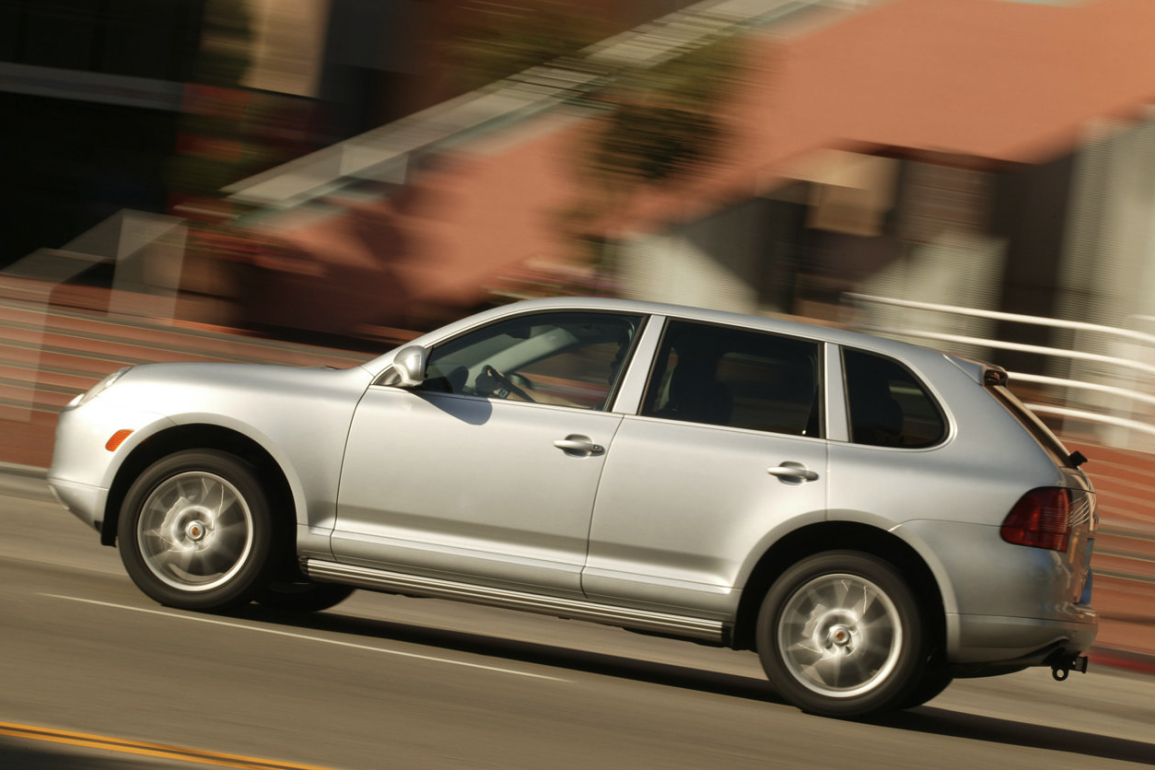
First Generation Porsche Cayenne Market Value & Pricing
The first-generation Porsche Cayenne (955/957) offers one of the best value propositions in the used luxury SUV market today. Thanks to early depreciation and a high-volume production run, entry-level models like the V6 Cayenne can be found for as little as $5,000 to $10,000, depending on condition and mileage. Well-maintained Cayenne S models, with their V8 power and added features, typically range from $8,000 to $15,000, with later 957 examples commanding slightly more. The Cayenne GTS, a favorite among enthusiasts, tends to hold its value better, often selling in the $15,000 to $25,000 range—especially with a manual transmission or lower mileage.
At the top of the market are the Turbo and Turbo S models, which originally sold for well over $100,000. Today, early Turbos can be found in the $10,000 to $20,000 range, but clean, low-mileage examples—particularly the 957 Turbo S (550 hp)—can fetch $25,000 to $35,000+ depending on spec and condition. These higher-end models often come fully loaded but carry higher maintenance costs. Overall, the first-gen Cayenne remains an affordable gateway into Porsche ownership, with rising interest in well-preserved examples signaling potential long-term appreciation, particularly for enthusiast-oriented variants like the GTS and Turbo S.
Factors That Affect Value
The value of a first-generation Porsche Cayenne (955/957) is influenced by a combination of mechanical condition, model variant, mileage, maintenance history, and even factors like color and transmission type. As interest in these early luxury performance SUVs grows—especially from enthusiasts and collectors—understanding the key factors that drive values can help buyers and sellers make smarter decisions. Here's an expert overview:
1. Model & Trim Level
Perhaps the most significant factor is which version of the Cayenne you're looking at. Base V6 models are the most affordable and least valuable, while V8-powered variants like the Cayenne S, GTS, Turbo, and Turbo S command much higher prices due to their performance and desirability. The GTS—especially with a manual transmission—is among the most sought-after enthusiast trims, while the Turbo S sits at the top of the market..
2. Mileage
As with most used vehicles, lower mileage equals higher value, but this is especially true for performance-oriented SUVs like the Cayenne. Buyers are cautious of high-mileage examples due to the potential for costly repairs and worn components. That said, a well-maintained high-mileage may be more desirable than a lower-mile car with deferred maintenance.
3. Service & Maintenance History
A comprehensive service record significantly boosts a Cayenne’s value. These are complex vehicles with known maintenance needs—such as cooling system overhauls, driveshaft bearing replacements, and transmission servicing. Buyers are willing to pay a premium for a Cayenne that has had regular oil changes, documented timing chain/tensioner work, and care from Porsche specialists. Lack of records is a red flag.
4. Transmission Type
While most Cayennes are automatics, a manual transmission—especially on the GTS or earlier V6/V8 models—is rare and highly desirable among enthusiasts. Manual GTS models, in particular, are already being seen as future collectibles and carry a strong value premium.
5. Interior & Exterior Condition
Wear and tear can significantly affect value. A clean interior with intact leather, functioning electronics, and a crack-free dash is far more appealing than a worn cabin. Likewise, rust-free bodywork, original paint, and minimal sunfade or dings will boost resale value.
6. Color & Options
Factory color combinations can influence value—rare or bold colors (such as Carmon Red, Jarama Beige, or Nordic Gold) paired with tasteful interiors can attract enthusiasts. Highly optioned examples with air suspension, PASM, sport seats, or premium sound systems are also more desirable.
7. Market Trends & Perception
As early luxury SUVs and analog performance vehicles gain in popularity, the first-gen Cayenne is slowly being re-evaluated by enthusiasts. Clean, well-kept examples—especially GTS and Turbo S models—are beginning to see value appreciation, while rough, neglected Cayennes still depreciate.
What You'll Pay
The most valuable first-gen Cayennes are low-mileage, well-documented examples of higher-performance trims—especially GTS and Turbo S models, ideally with rare colors, desirable options, and a clean, original condition. As the market matures, these factors will only become more important to buyers who want a Porsche that’s both fun to drive and poised to appreciate.
While they're attractive in terms of pricing, the base model VR6 Cayenne 955 is fairly underpowered compared to the amount of weight it has to haul around. The 3.2 L VR6 is super smooth, does an adequate job, and is quite reliable when serviced properly; it's just not a very enthralling drive. The 957 3.6 L VR6 Cayenne is a much better match to the car in terms of horsepower and torque, but these models definitely hold their value, many times coming in very near what you will pay for a similar Cayenne S.
The Cayenne S, with either a 4.5 L or 4.8 L V8, is the most common model that you're likely to find for sale and the best "all-around" Cayenne. Although all Cayennes feature the same towing capacity of just over 7,700lbs, a more powerful and torquey engine will be better for towing. If you plan on using your Cayenne as a tow vehicle, starting your search with the Cayenne S is probably your best bet.
If you can find a solid example, the Cayenne Turbo may just be the best all-around value. While it has unbeatable acceleration and performance for an SUV, the turbocharged engines are also said to be more reliable thanks to additional oil squirters and other stronger components. They've also depreciated to nearly the same price as a Cayenne S in some instances, meaning you can get quite a lot of truck for your money.
The Cayenne GTS and the Cayenne S Transsyberia seem to hold the most value, and as such, you will usually pay more for one of those models. That said, the GTS is fairly easy to find on the used market, and depending on the exact mileage and condition, you may see some pretty competitive prices.
Used Porsche Cayenne Pricing (955)
Cayenne Base - 2004-2006
$4,000-$12,000
Cayenne S - 2003-2006
$4,000-$12,000
Cayenne Turbo - 2004-2006
$8,000-$13,000
Cayenne Turbo S - 2006
$11,000-$18,000
Used Porsche Cayenne Pricing (957)
Cayenne Base - 2008-2010
$8,000-$14,000
Cayenne S - 2008-2010
$9,000-$15,000
Cayenne GTS - 2008-2010
$13,000-$25,000+
Cayenne Turbo - 2008-2010
$15,000-$22,000
Cayenne Turbo S - 2008-2010
$18,000-$25,000
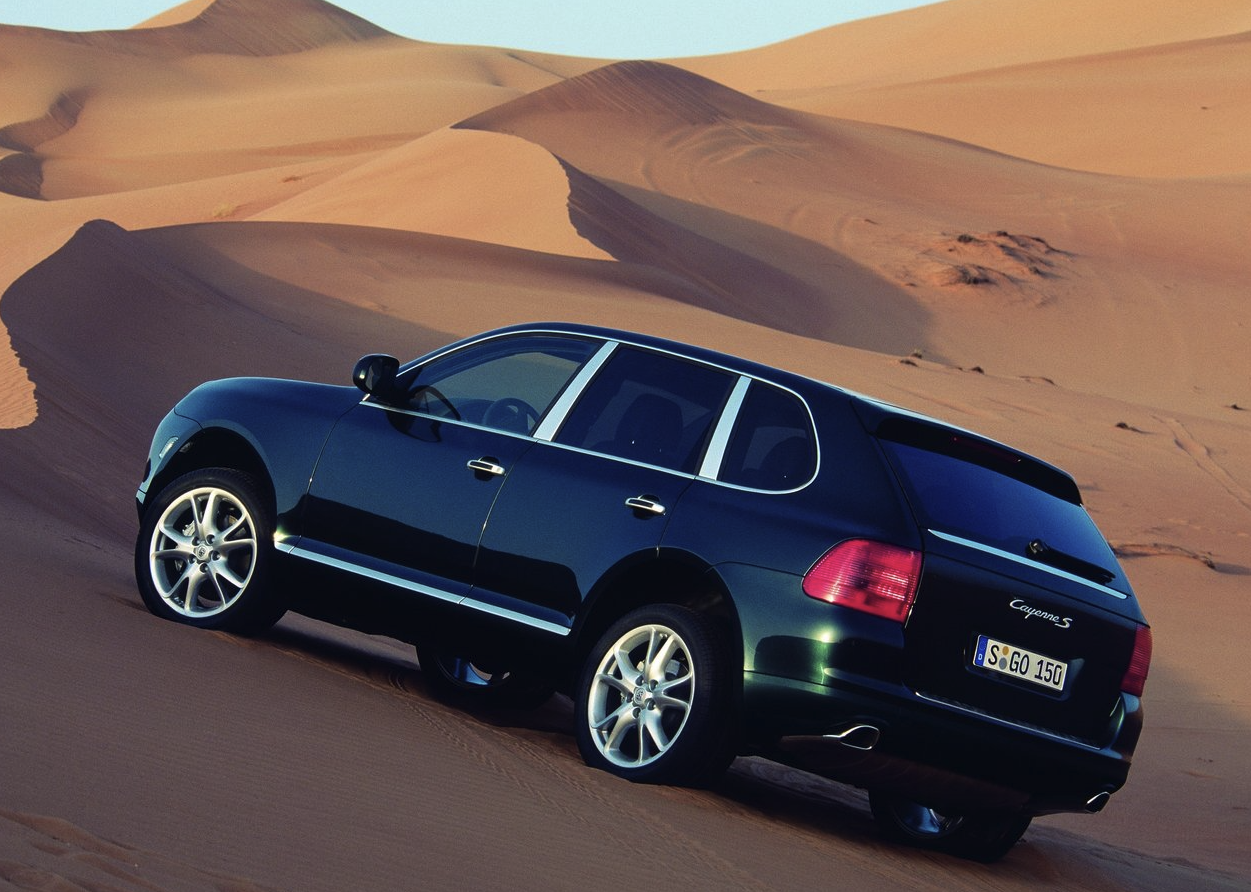
1st Gen Cayenne Driving Experience & What to Expect
What They Said at The Time
When the first-generation Porsche Cayenne was unveiled in 2002 and hit showrooms in 2003, the automotive world was buzzing with equal parts skepticism and curiosity. For decades, Porsche had been known for rear-engine sports cars like the 911, so the idea of a large, heavy SUV bearing the crest was considered controversial—even heretical—by purists. Yet when the press got behind the wheel, the tone quickly shifted from doubt to admiration.
Car and Driver, in its initial review of the Cayenne S and Cayenne Turbo, wrote,
“This is the SUV that can keep up with—or even beat—some sports cars in acceleration, handling, and braking.”
The magazine was particularly impressed by the Turbo’s performance, noting its ability to hit 60 mph in under 5.5 seconds while still maintaining off-road capability and daily comfort. They admitted, with some surprise, that the Cayenne had “authentic Porsche performance” baked into its DNA, despite its size and weight.
Motor Trend echoed this sentiment, calling the Cayenne
“the SUV with a soul.”
They praised its handling composure and refinement, noting that the Cayenne “doesn’t feel like a compromised off-roader—it feels like a tall sports car.” Their testers were especially impressed by the Cayenne’s ability to blend spirited on-road performance with real off-road capability, something that many of its luxury SUV rivals simply couldn't match at the time.
Even Autocar, a publication known for its critical eye, stated,
“The Cayenne is the most complete SUV we’ve ever driven. It can tow a horsebox through mud and then lap a racetrack with the poise of a sports saloon.”
Their initial reservations about Porsche's move into the SUV space were quickly dissolved by the Cayenne’s execution. The publication highlighted how the car’s dual personality—capable both in the wild and on the autobahn—was more than just marketing hype.
Not everyone was entirely sold, of course. The New York Times acknowledged the performance but lamented the styling, calling it
“bloated and awkward compared to Porsche’s lithe sports cars.”
And many early reviews questioned whether the Cayenne would dilute the Porsche brand. But even those skeptical voices couldn’t deny the Cayenne’s engineering excellence.
In retrospect, the media’s reaction to the first-gen Cayenne marked a turning point. What started as cautious appraisal became near-universal respect once the Cayenne proved itself not just as a luxury SUV, but as a legitimate Porsche. The early reviews helped reshape the narrative, and today, many see the first-gen Cayenne not just as a commercial success, but as a bold, technically brilliant vehicle that redefined what a performance SUV could be.
What to Expect Today
The first-generation Porsche Cayenne (955/957) delivers a driving experience that’s surprisingly engaging for a vehicle of its size and weight, and it remains one of the few luxury SUVs from its era that actually drives like a performance vehicle. Unlike many soft, cushy luxury crossovers of the early 2000s, the Cayenne was engineered with Porsche’s signature focus on dynamics. Whether you're behind the wheel of a base V6 model or a fire-breathing Turbo S, you’ll feel a level of road feel, balance, and driver engagement that most SUVs simply can’t match.
At the core of the Cayenne’s handling prowess is its sophisticated all-wheel-drive system, transaxle layout, and, in many models, adjustable air suspension with Porsche Active Suspension Management (PASM). Even in its heaviest forms, the Cayenne offers impressive body control, well-weighted steering, and a planted feel through corners—especially the GTS, which sits lower and comes with a sport-tuned suspension. The ride is firm but controlled, and despite its off-road capabilities, the Cayenne feels far more at home on winding roads and highways than climbing trails (though it can do that, too).
In terms of performance, expectations vary based on the model. The V6-powered Cayenne is competent but not quick, best suited for daily commuting or light-duty use. Step up to the Cayenne S or GTS, and you’ll enjoy a naturally aspirated V8 with a satisfying growl and solid acceleration (0–60 mph in roughly 6.0 seconds for the GTS). The Turbo and Turbo S, however, are in a league of their own—they're fast by modern standards, with 450–550 horsepower on tap and instant power delivery thanks to twin-turbocharged V8s. These models feel more like tall sports sedans than SUVs, and their ability to cover ground quickly is borderline shocking for a vehicle that weighs over 5,000 pounds.
When it comes to daily driving, the Cayenne shines. It’s comfortable, quiet, and spacious, with supportive seats, excellent visibility, and a premium feel throughout—even in early 955 models. The cargo area is generous, the back seats fold flat, and towing capacity is substantial (up to 7,700 lbs), making it a true multi-purpose vehicle. For those wanting something more special, the GTS or Turbo makes an excellent weekend cruiser with long-distance touring ability, serious backroad chops, and loads of character.
For potential buyers, it’s important to go in with eyes open: while the Cayenne drives like a modern Porsche, it’s still a high-performance luxury vehicle, and maintenance costs reflect that. But for those who choose wisely—ideally a well-maintained example with service history—the first-gen Cayenne delivers a rare combination of practicality, performance, and Porsche pedigree. Whether it’s your first Porsche or your daily workhorse, it’s a deeply satisfying SUV that’s aged better than most of its contemporaries, both in feel and in function.
Getting Real - Costs to Own & Maintenance
Owning and maintaining a first-generation Porsche Cayenne (955/957, 2003–2010) can be both a rewarding and surprisingly affordable experience—if you buy the right one. While these SUVs offer excellent performance and luxury for the money, they were complex, high-end vehicles when new, and that DNA remains when it comes to service and upkeep. Here’s a detailed look at what you can expect in terms of ownership costs, maintenance, parts, and insurance.
Ownership Costs & Maintenance: What to Expect
The first-gen Cayenne is not an economy SUV—it’s a performance-luxury machine that requires consistent, quality maintenance. Running costs will vary based on the model (V6, S, GTS, Turbo), but here are some general expectations:
Annual maintenance costs typically range from $1,500 to $3,500, depending on the car’s condition and which engine it has. V6 and naturally aspirated V8 models (S, GTS) are generally cheaper to maintain than Turbos or Turbo S models.
Common service items include:
Coolant pipes (plastic units on early V8s can fail—updated aluminum versions are ~$1,500–$2,500 installed)
Driveshaft support bearing (~$1,000–$1,500)
Cardan shaft and transfer case issues on higher-mileage models
Air suspension components, especially on Turbo or GTS with PASM (~$1,000–$2,500 per corner if replacement is needed)
Ignition coil packs and spark plugs, especially on V8s (~$600–$1,000)
Oil changes cost around $150–$250, depending on whether you go independent or dealer
Proactive maintenance is key—deferred repairs can quickly add up. Always look for a Cayenne with a documented service history.
Parts Availability & Pricing
One of the advantages of the 955/957 Cayenne is that parts are still widely available, both through Porsche and aftermarket suppliers. Because the platform shares components with the VW Touareg and Audi Q7 (especially suspension, drivetrain, and chassis parts), some service items can be surprisingly affordable.
OEM Porsche parts will carry a premium, but quality aftermarket alternatives are available for wear items (brakes, suspension, filters).
More complex parts—like electronic modules, air suspension, or transmission internals—can be expensive if they fail, so pre-purchase inspections are crucial.
Porsche Classic now supports older Cayenne models with increased parts availability, particularly for 955/957-era components.
Having access to a reputable independent Porsche mechanic can make a big difference in cost—dealership labor rates are typically $175+/hour, while a good independent shop might charge closer to $120–$140/hour.
Insurance Costs for a First-Gen Cayenne
Insurance for a 955 or 957 Cayenne is generally reasonable, especially when compared to newer or more exotic vehicles. Rates will depend on your location, driving record, and the model you choose.
Base V6 and Cayenne S models typically cost $800–$1,200/year to insure for full coverage.
GTS and Turbo models, especially if valued higher, can cost $1,200–$1,800/year depending on the insurer and usage.
If you’re planning on occasional use and own the car outright, you might consider a collector or limited-use policy through companies like Hagerty, which can significantly reduce costs.
The Cayenne is generally seen as a safe vehicle, and its age helps keep premiums in check, especially if it’s not your daily driver.
The first-generation Porsche Cayenne represents an incredible value today—but like any aging performance vehicle, the key to affordable ownership is buying a well-maintained example and staying ahead on preventive care. V6 and naturally aspirated V8 models are less expensive to maintain, while Turbos and GTSs offer serious performance at the cost of more complex upkeep. With solid parts availability, reasonable insurance, and expert help, a 955 or 957 Cayenne can be a reliable, powerful, and surprisingly versatile daily driver or weekend toy with true Porsche DNA.
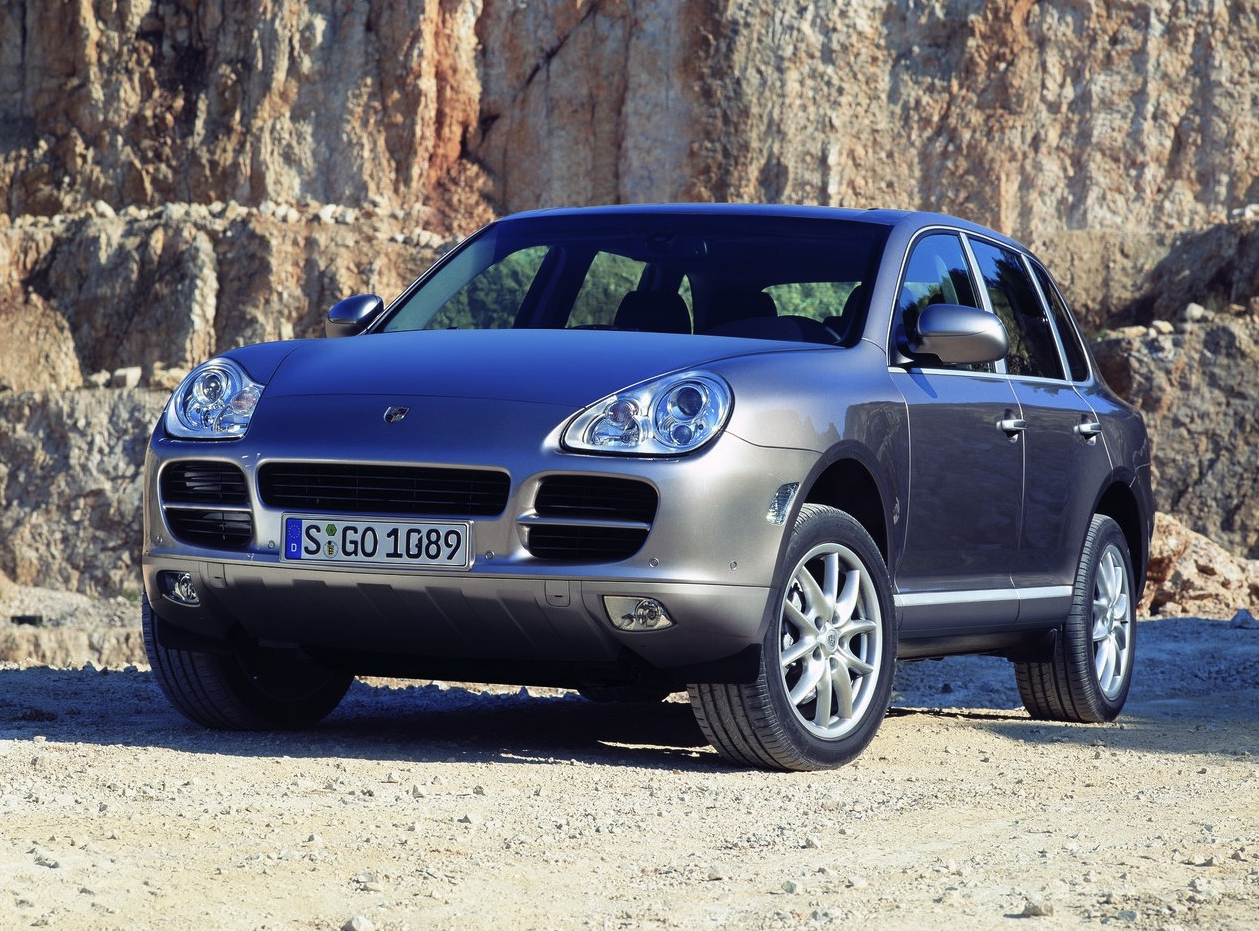
Common 1st Gen Porsche Cayenne Problems
What Buyers Should Know
The first-generation Cayenne (955/957, 2003–2010) is a rugged, capable, and rewarding vehicle—but it’s also known for some very specific problem areas. Many of these issues are well-documented and manageable if addressed early, but ignoring them can lead to expensive repairs. Here’s what buyers should be aware of before purchasing a first-gen Cayenne, along with the most common problems across all variants.
1. Coolant Pipe Failure (V8 Models)
One of the most infamous issues with early Cayenne S, GTS, and Turbo models (2003–2006) is the failure of plastic coolant pipes mounted between the V8 engine’s cylinder banks. These pipes become brittle with age and heat, eventually cracking and leaking coolant.
What to know: Porsche issued a revised aluminum pipe upgrade, which is the permanent fix.
Cost to repair: $1,500–$2,500 depending on labor and whether other items (like the starter) are serviced at the same time.
Buyer tip: Always ask if the aluminum pipe upgrade has been done—if not, budget for it immediately.
2. Driveshaft Center Support Bearing
The center support bearing on the driveshaft is a known weak point on early Cayennes. When it fails, you'll hear a thumping or vibration at low speeds or under load.
What to know: This issue affects all models (V6, V8, Turbo).
Cost to repair: $1,000 for a new driveshaft or $500–$700 for a remanufactured/replacement.
Buyer tip: Test drive the vehicle on both smooth and uneven roads and listen for vibration or knocking under acceleration.
3. Transfer Case Issues (Especially in 957s)
Later 957 models (2008–2010) are prone to transfer case wear, especially if the car has been driven hard or sees frequent AWD engagement. Symptoms include binding, jerking, or noise during low-speed turns.
What to know: Transfer case fluid should be changed regularly, even though Porsche did not initially call for this.
Cost to repair/replace: $2,000–$4,000.
Buyer tip: During a test drive, do tight turns in a parking lot and listen for grinding or popping. Also ask if the fluid has ever been changed.
4. Air Suspension & PASM Failures (High-End Models)
Cayenne models equipped with air suspension and PASM—especially Turbos and GTS models—can suffer from air strut leaks, failed compressors, or electronic malfunctions over time.
What to know: You may notice the car sitting low, riding unevenly, or flashing error codes.
Cost to repair: $1,500–$2,500 per corner for struts; $1,000+ for the compressor.
Buyer tip: Visually inspect the car’s ride height and look for a “chassis system failure” warning on the dash. If it's sitting uneven or sagging after being parked overnight, it's likely leaking.
5. Ignition Coil Packs & Misfires (V8s in Particular)
Coil packs can fail over time and lead to rough idling, misfires, and check engine lights. This is a common maintenance item, especially on older V8 models.
What to know: Typically happens around 70k–100k miles.
Cost to repair: $600–$1,000 for a full set of coil packs and plugs.
Buyer tip: If the seller claims “just needs a tune-up,” press for details—misfires can also indicate deeper issues.
6. Oil Leaks
The 928’s spiritual successor brings with it one of the same challenges: engine oil leaks, particularly around valve covers and camshaft seals.
What to know: Leaks are common but manageable if addressed early.
Cost to repair: $500–$1,500 depending on location and severity.
Buyer tip: Check the engine bay, belly pan, and undercarriage for oil residue.
7. Electrical Gremlins & Infotainment
While generally solid, older Cayennes can suffer from intermittent electrical faults, especially in models with early PCM units (infotainment), keyless entry, or heated seat controls.
What to know: Battery voltage and grounds are critical to overall system health.
Cost to repair: Varies—infotainment retrofits can run $1,000+, minor fixes much less.
Buyer tip: Make sure all electronics work—sunroof, windows, locks, HVAC, radio—and that no dash lights are on.
8. Brake Wear & Suspension Components
Due to their size and performance, Cayennes tend to wear through brake pads, rotors, and suspension bushings faster than expected—especially on heavier Turbo and GTS models.
What to know: Worn bushings can cause clunking or loose steering.
Cost to repair: Full brake job can be $1,000–$2,000; suspension refreshes add more.
Buyer tip: Listen for suspension noise and feel for vagueness or clunking on rough roads.
The first-gen Cayenne is a fantastic performer and great value, but it rewards the careful buyer. Avoiding poorly maintained examples is critical—buying cheap usually means paying later. Get a pre-purchase inspection (PPI) from a Porsche specialist, verify the coolant pipe upgrade, and walk away from any car with vague or incomplete service history. A well-cared-for Cayenne can offer years of performance SUV enjoyment—combining Porsche engineering, real utility, and rising classic appeal.
Buying A 1st Gen Porsche Cayenne FAQs
Here are all the questions we've received from readers considering a 1st Gen Cayenne for their driveway
What are the top five things to look for when buying a 1st gen Cayenne?
When buying a first-generation Porsche Cayenne (955/957, 2003–2010), your success hinges on knowing what to look for before signing the papers. These SUVs offer serious performance and utility, but they’re also complex and potentially costly if neglected. Here are the top five things you absolutely need to check before buying:
1. Full Maintenance & Service History
Above all else, service history is king. These are high-performance vehicles with known wear points, and many issues stem from deferred maintenance. Ask for:
Documentation of coolant pipe replacement (V8s)
Driveshaft bearing, transfer case, and brake service
Regular oil changes, fluid flushes, and suspension work
No history? Walk away—or budget thousands in potential repairs.
2. Coolant Pipes (for V8 Models)
Early Cayenne S, GTS, and Turbo models (955) came with plastic coolant pipes that often fail, leading to serious overheating risks. Porsche released a factory aluminum upgrade that solves the problem.
What to do: Ask specifically if the car has had the aluminum pipe update. If not, negotiate the price accordingly—it’s a $1,500–$2,500 job.
3. Driveshaft & Transfer Case Health
Listen for clunks, thumps, or vibrations under load or during acceleration—especially around 30–40 mph. These sounds can point to a failing center driveshaft bearing or a worn transfer case—both common issues.
What to do: Test drive the car on varied roads and ask about transfer case fluid changes (especially in 957s). Repairs can range from $700 to $4,000+ depending on the part.
4. Suspension & Air Ride System
If the Cayenne has air suspension and PASM, pay close attention to how it sits and rides. A sagging corner, uneven stance, or slow rise time could indicate failing air struts or compressors.
What to do: Let the car sit overnight and check the height the next day. Replacement costs per corner are $1,000–$2,500, and compressors add more.
5. Electronic Functions & Interior Condition
These SUVs were packed with tech for their time, and electrical gremlins can be expensive to chase down.
What to do: Make sure everything works—sunroof, windows, HVAC, seat heaters, infotainment, backup sensors, etc. Look for warning lights or system faults on the dash. Also, inspect the interior trim and wear points—repairs to dashboards, leather seats, and switchgear can be costly and time-consuming.
Always get a pre-purchase inspection (PPI) from a Porsche-experienced mechanic. A few hundred dollars upfront can save you thousands—and help you buy a first-gen Cayenne that’s not only fast and luxurious, but dependable too. When properly maintained, these SUVs are among the best performance bargains on the used market today.
Just how important are service records and ownership history?
Service records and ownership history are absolutely critical when buying a first-generation Porsche Cayenne (955/957). In fact, they can make the difference between an SUV that’s a thrilling performance bargain and one that’s a financial black hole.
Why Are Service Records So Important?
The first-gen Cayenne was a complex, high-performance luxury SUV when new—with a price tag that often pushed six figures. Now that these vehicles are 15–20 years old, proper maintenance is everything. They have known weak spots (coolant pipes, driveshafts, air suspension, coil packs, transfer cases, etc.), and if these issues haven’t been addressed, you’re inheriting someone else’s neglect.
Detailed service records show: That critical jobs like the aluminum coolant pipe upgrade or transfer case servicing were completed, that oil changes, spark plugs, and brake fluid were done on time, not skipped or delayed and that the car was cared for by someone who understood the importance of upkeep—often a better long-term indicator than mileage alone. Without these records, you're left guessing, and guesswork is expensive on a used Porsche.
How Much Does Ownership History Matter?
Ownership history gives you context. A Cayenne with one or two long-term owners who kept detailed records is vastly more desirable than one that’s bounced between six different hands with patchy paperwork. Flipping, neglect, or spotty title transfers can indicate deferred maintenance—or worse, hidden issues that have simply been passed down the line. Also important is that cars that have lived in harsh climates (extreme cold or salt-heavy environments) can show premature rust or corrosion. Off-road use, while rare, can accelerate wear on suspension and drivetrain components. A long-term owner who clearly maintained the car well? That’s gold.
For a first-gen Cayenne, a complete service history and solid ownership record are more than a nice bonus—they're a must. These records give you peace of mind, help you avoid expensive surprises, and directly affect resale value down the road. If a seller can’t provide maintenance documentation, treat that as a red flag—because even a low-priced Cayenne can become a very expensive lesson without a paper trail to back it up.
What are the most sought after 1st Gen Porsche Cayenne variants?
When it comes to first-generation Porsche Cayennes (955/957, 2003–2010), some variants have emerged as genuinely sought-after models—not just for their performance or features, but because of their rarity, enthusiast appeal, or long-term collectibility. While all Cayennes offer strong value, a few stand out in the eyes of collectors and knowledgeable buyers. Here are the most desirable:
1. Cayenne GTS (957, 2008–2010)
This is the enthusiast’s Cayenne, hands down. The GTS features a 405 hp 4.8L naturally aspirated V8, a lowered sport suspension, unique bodywork (borrowed from the Turbo), and Porsche Active Suspension Management (PASM) as standard. What really makes it special is the availability of a 6-speed manual transmission—a rarity among performance SUVs, and nearly unheard of in today’s market.
The GTS combines the best of both worlds: V8 performance, sharper handling than any other Cayenne of its era, and less complexity than the Turbo models. Manual GTS examples, especially in rare colors or well-optioned, are rapidly gaining value and attention in the Porsche world.
2. Cayenne Turbo S (955 – 2006, 957 – 2009–2010)
The Turbo S was the range-topping monster of the first-gen lineup. The 955 version produced 520 hp, while the 957 bumped it to 550 hp, making it one of the most powerful SUVs on the planet at the time. It came loaded with every available option: massive brakes, advanced air suspension, upgraded cooling, and luxury touches throughout.
Because they were expensive when new and sold in relatively low numbers, clean Turbo S examples—especially low-mileage or unmodified units—are highly desirable today. Enthusiasts appreciate the sheer power and exclusivity, while collectors are drawn to its top-dog status.
3. Manual Transmission Models (V6 and V8, Especially GTS)
While automatic transmissions were standard across most Cayennes, Porsche did offer a 6-speed manual on early base V6 models and later on select Cayenne S and GTS models. These are very rare—especially in North America—and increasingly sought after by purists who value analog engagement.
A manual 957 GTS is arguably the holy grail of driver-focused first-gen Cayennes, combining power, style, and control in a package no other SUV offered at the time. These are commanding a growing premium and are considered sleeper collectibles.
4. Cayenne S Transsyberia (2009)
Built to commemorate Porsche’s success in the grueling Transsyberia Rally, this limited-edition Cayenne S variant came with off-road enhancements, special paint schemes (often with orange accents), skid plates, locking rear differential, and other rally-inspired upgrades. Only about 600 units were produced worldwide, and fewer than 300 made it to the U.S.
The Transsyberia is the most off-road-capable and one of the rarest factory-built Cayennes. Its exclusivity and rally pedigree make it a prized addition for collectors looking for something unique.
5. Cayenne Turbo (955 and 957)
While not as rare as the Turbo S, the Cayenne Turbo was the first SUV that truly lived up to the Porsche name in terms of raw performance. The 955 Turbo (450 hp) and 957 Turbo (500 hp) both offered staggering acceleration, high-speed cruising ability, and full-time AWD, along with advanced features like air suspension, PASM, and huge brakes.
Turbo models in well-maintained, unmodified condition are increasingly appreciated by buyers who want top-tier performance without spending GTS or Turbo S money. When properly sorted, they’re still immensely capable machines.
If you’re looking for long-term collectibility, the manual GTS and Transsyberia are at the top of the list. For sheer performance and prestige, the Turbo S is unmatched. And if you want the best value in a high-performance SUV, a clean Cayenne Turbo or well-kept Cayenne S is hard to beat. As appreciation grows for analog-era Porsche engineering, these variants are quickly becoming modern classics in their own right.
What are the best 1st Gen Porsche Cayenne options?
When shopping for a first-generation Porsche Cayenne (955/957, 2003–2010), the right factory options and extras can significantly enhance both the driving experience and the vehicle’s desirability on the resale market. While many Cayennes came well-equipped, there were numerous optional features—some rare, some performance-focused—that can separate a good example from a great one. Here are the most valuable and sought-after options to look for:
1. Air Suspension with PASM (Porsche Active Suspension Management)
One of the most transformative options for ride quality and handling, air suspension with PASM was standard on Turbo and Turbo S models, and optional on others. It allows the vehicle to adjust ride height and stiffness at the press of a button—ideal for both spirited driving and off-road use.
Look for the “chassis control” button inside. This option just offers a smoother ride and sharper handling and increases value, especially on Cayenne S and GTS models.
2. 6-Speed Manual Transmission (Rare but Desirable)
Manual transmissions were available on early V6 Cayennes and later on the Cayenne GTS—and are now considered highly collectible. A manual Cayenne GTS, in particular, is one of the most sought-after configurations for driving purists. Extremely rare, especially in North America, but its a big value driver, especially the manual GTS models which are increasing in value. Adds a unique analog feel to an otherwise tech-heavy SUV.
3. Sport Seats or Adaptive Sport Seats
Porsche’s sport seats offer additional bolstering and support, making a big difference in spirited driving. These were more common in GTS and Turbo models but were optional on others. Look for adjustable thigh and side bolsters and you can find this option on both full leather or Alcantara cars.
4. Factory Tow Package
The Cayenne has serious towing capability—up to 7,700 lbs—but only if equipped with the OEM towing package (which includes wiring and hitch mounting points). Great for utility and resale. While you can get aftermarket hitches, they don’t carry the same value or integration. A must-have for those planning to tow trailers, boats, or track cars.
5. Locking Rear Differential (Off-Road Package)
Some Cayennes were optioned with an off-road tech package, which included a locking rear diff, additional underbody protection, and off-road driving modes. Rare, mostly found on early V8s or Transsyberia models. Increases trail capability and collector interest and is a must-have for overlanding enthusiasts or those planning off-road use.
6. PCM with Navigation (Period Correct, But Optional)
While outdated by today’s standards, the original Porsche Communication Management (PCM) system with navigation was a premium feature when new. Not as important functionally today, but nice for originality. Well-kept PCM systems add value on collector-grade cars.
7. Premium Audio Systems (Bose or Burmester)
Cayennes could be optioned with a Bose surround sound system, which significantly improved audio quality. Look for “Bose” branding on speaker grilles. Great for daily comfort and luxury appeal.
8. Heated & Ventilated Front and Rear Seats
Comfort options like heated front and rear seats, ventilated seats, and multi-zone climate control are big bonuses—especially in colder or warmer climates. Rear heated seats were less common and a luxury perk. Ventilated seats rare but found on well-optioned GTS and Turbo models.
9. Unique Paint & Interior Color Combos
Rare or Paint-to-Sample (PTS) exterior colors—like Carmon Red, Nordic Gold, or Jarama Beige—combined with special interiors (Sand Beige, Cocoa Brown, Alcantara headliners) can make a Cayenne stand out and be more collectible. Enthusiast buyers often seek unusual factory color combos. Increases long-term interest and uniqueness.
If you’re looking to buy a first-gen Cayenne that offers the best mix of performance, comfort, and long-term value, prioritize models with air suspension and PASM, manual transmission (if you can find one), sport seats, and the tow package. High-end trims like the GTS or Turbo S often include many of these as standard or commonly optioned features. And remember—a well-optioned Cayenne with documented service history is far more valuable than a bare-bones example, no matter how good the deal looks upfront.


